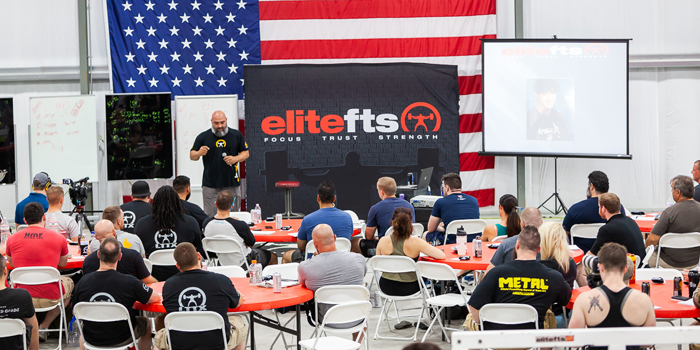
The elitefts Learn to Train X (LTTX) seminar took place in early August, bringing together trainers, coaches, athletes, and competitors across the powerlifting industry for the intensive three-day event. Participants were able to attend lectures from respected strength and performance educators, and also had the opportunity to experience hands-on instruction at training stations dedicated to perfecting squat, bench press, and deadlift techniques. As part of the lecture series, Nate Harvey spoke to the group about some simple techniques that can have a big impact on athletic performance.
After providing a detailed breakdown of how to box squat correctly, Harvey moved on to a few more “simple techniques” that LTTX attendees could implement when training young athletes. He discussed: the proper way to jump and land, scapular retraction and depression, and simply training what you say you’re training. In this particular clip, Harvey switches gears to provide some personal advice on teaching athletes how to train themselves – a not-so-simple technique that requires trust, buy-in, strategy, and effort.
Have Faith in the System
Harvey explains that he had enough faith in his “simple techniques” system that he could avoid being the dreaded drill-sergeant type of coach. He didn’t have to micromanage his athletes, because he was ultimately able to teach them how to train themselves, thereby educating the athletes to self-assess and self-correct.
If all strength coaches could do the same, they would be “golden,” as Harvey puts it. And yet, teaching athletes to train is not without its challenges. Many coaches complain about dealing with millennial athletes – in reality, their behavior generally stems from the fact that they simply don’t know better. Millennials have spent their whole lives playing their particular sport, but haven’t been pushed in the way that strength training pushes them. It’s the job of the strength and conditioning staff to show them what hard work and training really means. Whether it’s time-sets, or working one-on-one with an athlete for a day to near-failure, if coaches are able to teach their athletes how to train, it makes everything else down the line so much easier.
Cultivate Athlete Buy-In
Much of Harvey’s advice is positioned around the central theme of generating buy-in. If the athletes don’t buy in to the program, then it leaves the coach with no alternative other than being a drill-sergeant. However, this kind of coaching style is not sustainable or effective in the long run. And so, to cultivate buy-in from the athletes, target those that have already bought in to the system and use them to incite change in others. These “change champions” may be able to reach those athletes that you cannot seem to connect with, just because they are another voice communicating the same message. Let these athletes be your advertisers.
Another component of cultivating buy-in is establishing and maintaining coach credibility. A significant part of this is, as a coach, training yourself. As Harvey asks, “Why are you in a weight room if you don’t like to train?” The athletes will notice if their strength and conditioning coach does not walk the walk or practice what he preaches. This kind of attitude erodes coach credibility and decreases buy-in for your system or program.
Focus Energy Where It Matters
It takes a significant amount of time and energy to micromanage. Harvey advises the group that, if they can, “teach them, don’t make them.” In other words, if athletes are simply doing exercises to appease their drill-sergeant coach, in the long run they will not make any progress. Naturally, there are certain groups with specific dynamics in which coaches have to do more order-giving, particularly on the front-end of training. Nonetheless, as Harvey advises, coaches should still make an effort to transition the message on the back-end to more of a learning opportunity.
On a related note, Harvey recommends that the coaches bring along the “weak links”, but don’t spend all of their time on them. In any group, coaches will have athletes with bad attitudes, who are distracted, or who won’t listen. More often than not, these athletes are dealing with issues outside of the weight room, either in their school or home life. Harvey advises coaches to make an effort to determine what this root problem might be, but without letting it consume all of their time. It seems like five percent of athletes take up 95 percent of coaches’ energy. As such, ultimately, coaches must focus their energy on the athletes that actually want to learn and train.
Reward Effort First
Finally, Harvey encourages the group to focus first and foremost on rewarding effort, not super-star performances. It’s often the case that there will be a genetically advantaged athlete who is really successful, but who doesn’t have to train very hard. If this athlete walks into the weight room during a training session and the coaches immediately go over to “bro-hug” him and show him special attention, this is distracting to the other athletes. They will notice this behavior, and it tends to erode their buy-in to the strength program. They may think, “Why is the lazy, super-star athlete always the center of attention, while I’m over here working hard, unnoticed?” Even if an athlete is not very successful in their particular sport, that’s not necessarily the concern of the strength coach. Their job is to focus on rewarding hard work and effort in the weight room – and not just when it comes to the star-athletes.









